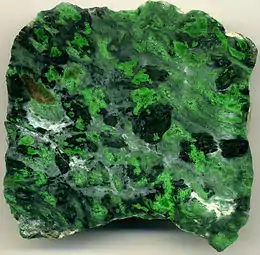| Kosmochlor | |
|---|---|
 Chromite (metallic black), kosmochlor pyroxene (emerald green to dark green to black), chromian jadeite pyroxene (green), chromiferous arfvedsonite amphibole (green or gray), symplectite (green, a finely-crystalline mineral mix of mostly chromian jadeite) | |
| General | |
| Category | Inosilicate mineral |
| Formula (repeating unit) | NaCr3+Si2O67 |
| IMA symbol | Kos[1] |
| Strunz classification | 9.DA.25 |
| Crystal system | Monoclinic |
| Crystal class | Prismatic (2/m) (same H-M symbol) |
| Space group | C2/c |
| Unit cell | a = 9.57, b = 8.71 c = 5.26 Å; β = 107.49°; Z = 4 |
| Identification | |
| Color | Emerald-green |
| Crystal habit | Prismatic crystals and fibrous aggregates |
| Twinning | Simple, lamellar on {100} and {001} |
| Cleavage | Good on {110} parting on {001} |
| Mohs scale hardness | 6 |
| Luster | Vitreous |
| Streak | Light green |
| Diaphaneity | Semitransparent |
| Specific gravity | 3.51-3.60 |
| Optical properties | Biaxial (-) |
| Refractive index | nα = 1.766 nγ = 1.781 |
| Birefringence | δ = 0.015 |
| Pleochroism | X = yellowish green; Y = blue-green, grass-green; Z = emerald-green |
| Dispersion | r > v |
| References | [2][3][4] |
Kosmochlor is a rare chromium sodium clinopyroxene with the chemical formula NaCr3+Si2O6.
The name is from German kosmisch, for its occurrence in meteorites, and the Greek chlor, for green.[4] It was first reported in 1897 from the Toluca meteorite, Jiquipilco, Mexico.[2]
It occurs as a major constituent of some jadeitites and as an accessory mineral of some iron meteorites. Associated minerals include cliftonite (graphite), chromian diopside, troilite at Toluca; daubreelite, krinovite, roedderite, high albite, richterite, chromite (Canyon Diablo); and jadeite, chromite and chlorite (Burma).[3]
References
- ↑ Warr, L.N. (2021). "IMA–CNMNC approved mineral symbols". Mineralogical Magazine. 85 (3): 291–320. Bibcode:2021MinM...85..291W. doi:10.1180/mgm.2021.43. S2CID 235729616.
- 1 2 Kosmochlor on Mindat
- 1 2 Kosmochlor in the Handbook of Mineralogy
- 1 2 Kosmochlor on Webmin
This article is issued from Wikipedia. The text is licensed under Creative Commons - Attribution - Sharealike. Additional terms may apply for the media files.